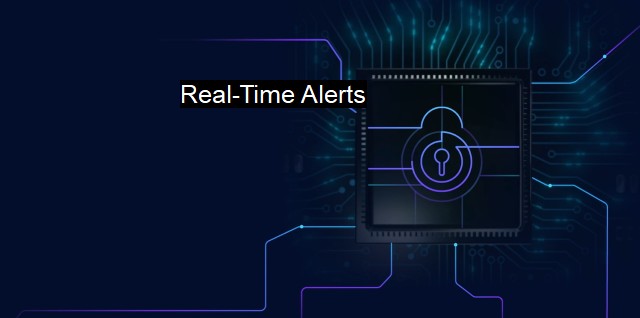What are Real-Time Alerts?
Empowering Enterprises with Real-Time Cybersecurity Alerts for Securing Digital Assets
Real-time alerts are an essential and indispensable function particularly in antivirus systems. The term "real-time alerts" refers to the immediate notifications that are dispatched by cybersecurity systems when threats or abnormal activities are detected. Unlike traditional alerts that could only identify the issues after they occurred or during regular system checks, real-time alerts are instantly generated and transmitted the moment a potential issue arises.Typically, the concept of real-time alerts is straightforward and easy to comprehend. When antivirus software identifies threats, it instantly sends an alert to the system operator, notifying them of the threat's existence. The alert is instantaneous and real-time; it isn’t delayed, postponed, or overlooked.
The major goal of real-time alerts in terms of cybersecurity is to provide instantaneous identification of threats and prevent potential security breaches. In today’s era of widespread online activities and transactions, security challenges have significantly increased; any delay can result in a disastrous loss of data and severe breaches.
When integrated into an antivirus system, real-time alerts always monitor and scrutinize the ongoing activities in the device or network. Using pattern recognition and predictive algorithms, the antivirus software continually evaluates the system's health. It identifies activities that deviate from the norm, such as a sudden surge in data transfers or access from an unfamiliar location. If such behavior is detected, the antivirus instantly sends a real-time alert to the system administrators, urging them to investigate the reported issue.
Many times, these real-time alerts are associated with a spectrum of threat intelligence services, leveraging global databases of known threats, reported vulnerabilities, and threat actor behavioural patterns. This database-driven threat evaluation enables the antivirus to contrast observed activities to known threat patterns, enhancing the accuracy of real-time alerts.
Interactive dashboards display these alerts to the system administrators. The dashboards categorize the alerts based on severity level, threat type, affected zone, breach attempt time, and more. The actionable intelligence provided by real-time alerts helps administrators to prioritize, visualize and know precisely where and how to act.
The matchmaking speed of the real-time threat detection, intelligent error correction capabilities, and the precision in identification make real-time alerts incredibly vital. Real-time alerts can not only identify well-known viruses and malware but also emerging cyber threats that may be disregarded by basic antivirus defenses. They offer robust cybersecurity solutions that consist of thorough monitoring, instant caution, and preventative remediation tools to ensure the utmost level of digital security.
In addition to detecting external threats, real-time alerts can also recognize internal threats. This has become crucial given that insider threats constitute a considerable percentage of cybersecurity incidents. Therefore, real-time alerts optimize security by enabling organizations to monitor employees, and counter potential insider threats.
Real-time alerts play a fundamental role in ensuring that organisations and individuals are always a step ahead in terms of cybersecurity. During a time where cyber threats have become more sophisticated and advanced, employing the real-time alerts capability in antivirus and cybersecurity systems is a necessity. Real-time alert mechanism proactively minimizes cyber risk, optimizes endpoint defense, and provides to any organization an advantageous edge in cybersecurity.

Real-Time Alerts FAQs
What are real-time alerts in cybersecurity and antivirus?
Real-time alerts are notifications that are triggered and delivered immediately as soon as a security threat is detected by the antivirus software in real-time. These alerts are designed to notify the user of any potential security breach, virus, or malware to enable quick and effective action to minimize the risk of data loss, system damage, or cyberattack.How do real-time alerts work in cybersecurity and antivirus?
Real-time alerts work by continuously monitoring the system and analyzing network and system behavior against known threats and attack patterns. The antivirus software uses advanced algorithms and machine learning to analyze data in real-time and detect any suspicious activity. Once a potential threat is detected, the software generates an alert message and sends it to the user via email, SMS, or dashboard notification.What types of real-time alerts are available in antivirus and cybersecurity software?
Some common types of real-time alerts include virus alerts, malware alerts, intrusion detection alerts, firewall alerts, and email security alerts. These alerts can be customized based on the user's preferences and requirements to ensure that they receive critical notifications in real-time.Why are real-time alerts essential in cybersecurity and antivirus?
Real-time alerts are essential in cybersecurity and antivirus as they enable quick and effective action to mitigate the impact of security threats. By receiving real-time alerts, users can take immediate steps to isolate the infected system, block the malicious activity, or patch the vulnerability. This ensures that the user can identify and address any potential security breaches before they cause significant damage to the system.| | A | | | B | | | C | | | D | | | E | | | F | | | G | | | H | | | I | | | J | | | K | | | L | | | M | |
| | N | | | O | | | P | | | Q | | | R | | | S | | | T | | | U | | | V | | | W | | | X | | | Y | | | Z | |
| | 1 | | | 2 | | | 3 | | | 4 | | | 7 | | | 8 | | |||||||